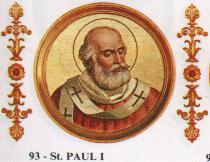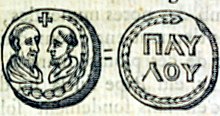
Feastday: June 28
Birth: 700
Death: 767
Pope from 757-767. The brother of Pope Stephen 11 and a Roman, he was educated in the Lateran Palace, became a deacon under Pope Zachary, and wielded considerable influence in his brother's administration. Elected to succeed Stephen, he took as his primary concern the threat posed to Rome and the Papal States by the Lombards. Paul secured an alliance with the Frankish king Pepin the Short, thereby cementing the relationship between the Holy See and the Frankish Empire which culminated with the historically significant alliance between Pope Leo III and Charlemagne. Paul also opposed the Iconoclast policies of the Byzantine emperor Constantine V, thereby exacerbating further the deteriorating relationship between the papacy and the Byzantine Empire. He died on June 28 at St. Paul's Outside the Walls, in Rome.
Pope Paul I (Latin: Paulus I; 700 – 28 June 767) was the bishop of Rome and ruler of the emerging Papal States from 29 May 757 to his death. He first served as a Roman deacon and was frequently employed by his brother, Pope Stephen II, in negotiations with the Lombard kings.
Rise
Paul was a Roman aristocrat. He and his brother Stephen had been educated for the priesthood at the Lateran Palace. Stephen became pope in 752. After Stephen's death on 26 April 757, Paul prevailed over a faction that wanted to make Archdeacon Theophylact pope and was chosen to succeed his brother by the majority that wished a continuation of Stephen's policy.
Pontificate
 Seal of Paul I, with Greek text ΠΑΥΛΟΥ (Paulou, "of Paul")
Seal of Paul I, with Greek text ΠΑΥΛΟΥ (Paulou, "of Paul")
Paul I's reign was dominated by relations with the Frankish and Lombard kings and with the Eastern Roman emperor. He wrote to Pepin the Younger that the Frankish alliance should be maintained unimpaired. Paul was likely concerned of the danger posed by the Lombard king Desiderius. The Lombards held the cities of Imola, Osimo, Bologna, and Ancona, which were claimed by the papacy, and in 758 seized upon the duchies of Spoleto and Benevento.
On his return from suppressing a revolt in Benevento, Desiderius visited Rome and compelled Paul to write to Pepin asking him to concede all the Lombard claims. He promised to return Imola, but on condition that the pope should persuade Pepin to send back Lombard hostages held by the Franks. Paul agreed and sent a letter to Pepin. Pepin found it advisable to maintain good relations with Desiderius, and Paul apparently accomplished little by his double-dealing. Later, however, Pepin gave the pope some support and acted as arbiter between the Roman and Lombard claims.
In 765, papal privileges were restored in the duchies of Benevento and Tuscany and partially in Spoleto. Meanwhile, the alienation from Eastern Roman Empire grew greater. Several times, especially in 759, Paul feared that the emperor would send an armament against Rome. Paul lived in continual dread lest Eastern Roman ambitions turn the Frankish influence in favor of the Lombards. This was actually attempted, but Pepin held to his original foreign policy regarding Italy.
Paul died in Rome on 28 June 767.





